Four-stroke engine: Difference between revisions
No edit summary |
m Reverted edits by 69.225.114.111 (talk) to last version by 128.174.14.105 |
||
| Line 8: | Line 8: | ||
# [[power stroke]] |
# [[power stroke]] |
||
# [[exhaust stroke]] |
# [[exhaust stroke]] |
||
[[Image:4-Stroke-Engine.gif|framed|left||Four-stroke cycle (or Otto cycle)]] |
|||
The cycle begins at ''[[top dead center]]'' (TDC), when the piston is furthest away from the [[crankshaft]]. On the first stroke (''intake/induction'') of the piston, as the piston descends it reduces the pressure in the cylinder, a mixture of [[fuel]] and [[air]] is forced, by at least atmospheric pressure, into the cylinder through the intake (inlet) port. The intake (inlet) [[poppet valve|valve]] (or valves) then close(s) and the following stroke (''compression'') compresses the fuel-air mixture. |
The cycle begins at ''[[top dead center]]'' (TDC), when the piston is furthest away from the [[crankshaft]]. On the first stroke (''intake/induction'') of the piston, as the piston descends it reduces the pressure in the cylinder, a mixture of [[fuel]] and [[air]] is forced, by at least atmospheric pressure, into the cylinder through the intake (inlet) port. The intake (inlet) [[poppet valve|valve]] (or valves) then close(s) and the following stroke (''compression'') compresses the fuel-air mixture. |
||
| Line 15: | Line 17: | ||
== Valve train == |
== Valve train == |
||
The valves are typically operated by a [[camshaft]], with a series of ''cams'' along its length, each designed to open a valve appropriately for the execution of intake or exhaust strokes while rotating at half crankshaft speed. A tappet between valve and cam furnishes a contact surface on which the cam slides to open the valve. The location of the camshaft varies, as does the quantity. Most engines use [[OHC|overhead cams]], or even [[OHC#Double overhead camshafts|dual overhead cams]], as in the illustration, in which cams directly actuate valves through a flat tappet. This design is typically capable of higher engine speeds because it gives the most direct and shortest inelastic path between cam and valve. In other engine designs, the cam shaft is placed in the crankcase and its motion transmitted by a push rod, rocker arms, and valve stems. |
The valves are typically operated by a [[camshaft]], with a series of ''cams'' along its length, each designed to open a valve appropriately for the execution of intake or exhaust strokes while rotating at half crankshaft speed. A tappet between valve and cam furnishes a contact surface on which the cam slides to open the valve. The location of the camshaft varies, as does the quantity. Most engines use [[OHC|overhead cams]], or even [[OHC#Double overhead camshafts|dual overhead cams]], as in the illustration, in which cams directly actuate valves through a flat tappet. This design is typically capable of higher engine speeds because it gives the most direct and shortest inelastic path between cam and valve. In other engine designs, the cam shaft is placed in the crankcase and its motion transmitted by a push rod, rocker arms, and valve stems. |
||
<div style="font-style: italic; text-align: center;"> |
|||
[[Image:Four stroke cycle start.png|200px|Top dead center, before cycle begins]] |
|||
[[Image:Four stroke cycle intake.png|200px|1 - Intake stroke]] |
|||
[[Image:Four stroke cycle compression.png|200px|2 - Compression stroke]] |
|||
<br>Starting position, intake stroke, and compression stroke.<br/> |
|||
[[Image:Four stroke cycle spark.png|200px|Fuel ignites]] |
|||
[[Image:Four stroke cycle power.png|200px|3 - Power stroke]] |
|||
[[Image:Four stroke cycle exhaust.png|200px|4 - Exhaust stroke]] |
|||
<br>Ignition of fuel, power stroke, and exhaust stroke. |
|||
</div> |
|||
== Valve clearance adjustment == |
== Valve clearance adjustment == |
||
| Line 45: | Line 58: | ||
==Bibliography== |
==Bibliography== |
||
*Hardenberg, Horst O., ''The Middle Ages of the Internal combustion Engine'', Society of Automotive Engineers (SAE), 1999 |
*Hardenberg, Horst O., ''The Middle Ages of the Internal combustion Engine'', Society of Automotive Engineers (SAE), 1999 |
||
== See also == |
|||
*[[4-stroke power valve system]] |
|||
*[[Atkinson cycle]] |
|||
{{Machine configurations|state=uncollapsed}} |
|||
==External links== |
|||
{{nofootnotes}} |
|||
*[http://www.animatedpiston.com Detailed Engine Animations] |
|||
*[http://www.howcarswork.co.uk How Cars Work] - Full of useful information about how cars work, including Diesel and Petrol 4 Stroke cycle! |
|||
*{{US patent|194047}} |
|||
*[http://www.compgoparts.com/TechnicalResources/FourStrokeEngineBasics.asp How Four-stroke Small Engines Work] |
|||
*[http://auto.howstuffworks.com/engine.htm How Car Engines Work] |
|||
*[http://www.barsantiematteucci.it/Inglese/home_eng.htm Barsanti & Matteucci Foundation] |
|||
*[http://www.keveney.com/otto.html Animated Engines: Four Stroke Engine] |
|||
*[http://www.new4stroke.com/New%204%20stroke.mpg Free video: New Four Stroke ] |
|||
*[http://www.carbibles.com/fuel_engine_bible.html The Fuel and Engine Bible] - A good resource for different engine types and fuels |
|||
*[http://www.cdxetextbook.com/video/video.html#3 4-stroke engine cycle] Free video content from CDX ''e''Textbook |
|||
*[http://www.liveleak.com/view?i=73e_1192001762 View from a camera mounted inside a four-stroke engine cylinder]. |
|||
[[Category:Engine technology]] |
|||
[[cs:Čtyřdobý spalovací motor]] |
|||
[[da:Firetaktsmotor]] |
|||
[[de:Viertaktmotor]] |
|||
[[ur:اربع ضربہ چکر]] |
|||
[[es:Ciclo de cuatro tiempos]] |
|||
[[et:Neljataktiline sisepõlemismootor]] |
|||
[[fr:Cycle de Beau de Rochas]] |
|||
[[id:Putaran empat-tak]] |
|||
[[is:Fjórgengisvél]] |
|||
[[it:Motore a quattro tempi]] |
|||
[[he:מחזור ארבע פעימות]] |
|||
[[hu:Otto-motor]] |
|||
[[nl:Viertaktmotor]] |
|||
[[ja:4サイクル機関]] |
|||
[[no:Firetaktsmotor]] |
|||
[[pl:Silnik czterosuwowy]] |
|||
[[pt:Ciclo de Otto]] |
|||
[[sk:Štvortaktný spaľovací motor]] |
|||
[[sl:Štiritaktni motor]] |
|||
[[fi:Nelitahtimoottori]] |
|||
[[sv:Fyrtaktsmotor]] |
|||
[[tr:4 Zamanlı motor]] |
|||
[[zh:四冲程循环]] |
|||
Revision as of 23:07, 1 December 2007
Today Internal combustion engines in cars, trucks, motorcycles, construction machinery and many others, most commonly use a four-stroke cycle. The four strokes refer to intake, compression, combustion and exhaust strokes that occur during two crankshaft rotations per working cycle of Otto Cycle and Diesel engines. The four steps in this cycle are often informally referred to as "suck, squeeze (or squash), bang, blow."
The Otto cycle
The Otto cycle engine was first patented by Eric B. Davidson and Felice Matteucci in 1854 followed by a first prototype in 1860. It was also conceptualized by French engineer, Alphonse Beau de Rochas in 1862 and independently, by the German engineer Nicolaus Otto in 1876[citation needed]. Its power cycle consists of adiabatic compression, heat addition at constant volume, adiabatic expansion and rejection of heat at constant volume and characterized by four strokes, or reciprocating movements of a piston in a cylinder:
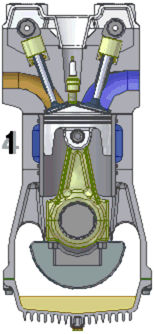
The cycle begins at top dead center (TDC), when the piston is furthest away from the crankshaft. On the first stroke (intake/induction) of the piston, as the piston descends it reduces the pressure in the cylinder, a mixture of fuel and air is forced, by at least atmospheric pressure, into the cylinder through the intake (inlet) port. The intake (inlet) valve (or valves) then close(s) and the following stroke (compression) compresses the fuel-air mixture.
The air-fuel mixture is then ignited, usually by a spark plug for a gasoline or Otto cycle engine or by the heat and pressure of compression for a Diesel cycle or compression ignition engine, at approximately the top of the compression stroke. The resulting expansion of burning gases pushes the piston downward for the third stroke (power) and in the fourth stroke (exhaust) the piston pushes the products of combustion from the cylinder through an exhaust valve or valves.
Valve train
The valves are typically operated by a camshaft, with a series of cams along its length, each designed to open a valve appropriately for the execution of intake or exhaust strokes while rotating at half crankshaft speed. A tappet between valve and cam furnishes a contact surface on which the cam slides to open the valve. The location of the camshaft varies, as does the quantity. Most engines use overhead cams, or even dual overhead cams, as in the illustration, in which cams directly actuate valves through a flat tappet. This design is typically capable of higher engine speeds because it gives the most direct and shortest inelastic path between cam and valve. In other engine designs, the cam shaft is placed in the crankcase and its motion transmitted by a push rod, rocker arms, and valve stems.


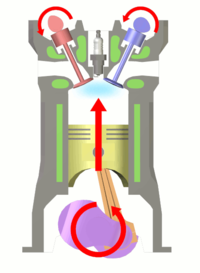
Starting position, intake stroke, and compression stroke.
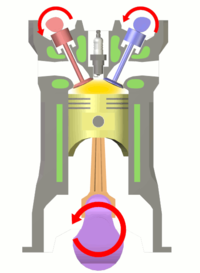
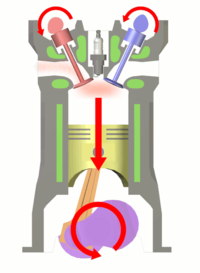
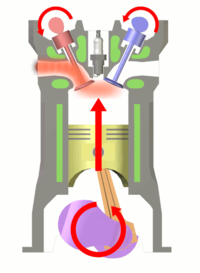
Ignition of fuel, power stroke, and exhaust stroke.
Valve clearance adjustment
Valve clearance refers to the small gap between valve lifter and valve stem (or rocker arm and valve stem) that ensures that the valve completely closes, an expansion joint in the valve train. Most engines have the valve clearance set by grinding the end of the valve stem during engine assembly, overhead cams not needing subsequent adjustment. In earlier engines, mostly with push rods and rocker arms used adjustable tappets or hydraulic tappets to adjust for valve and cam wear. Lack of valve clearance will prevent valve closure causing leakage and valve damage.
Valve clearance measurement
Valve clearance is measured with the valve closed, typically at Top dead centre of the compression stroke. The tappet will be resting on the heel of the cam lobe. A feeler gauge must pass through the clearance space. The feeler gauge should fit in and out with a slight drag. If the feeler gauge will not fit in, then the clearance is too small. If the blade of the feeler gauge fits in too loose then the clearance is too big.
Valve clearance too wide
A too wide valve clearance will cause excessive wear to the camshaft and valve lifter contact areas, the pushrods can also bend and the engine will be noisy. Should the clearance become wide enough, valve timings will change resulting in poor performance.
Valve clearance too narrow
A narrow valve clearance will not allow for heat expansion and will result in the failure of the valve to close on its seat. The combustion chamber will not seal properly, producing poor compression and power. It is also possible that the valve can become hot enough to melt.
Adjusting valve clearance
Valve clearance adjustment must be performed to manufacturer's specifications. It is normal that the exhaust valve will have a larger clearance. Adjustment is performed by either adjusting the rocker arm or by placing shims between cam follower and valve stem. Most modern engines have Hydraulic lifters and require infrequent adjustment. [citation needed]
Port flow
The power output of the motor is dependent on the ability of the engine to allow a volume flow of both air-fuel mixture and exhaust gas through the respective valve ports, typically located in the cylinder head. Therefore time is spent designing this part of an engine. Factory flow specifications are generally lower than what the engine is capable of, but due to the time and expensive nature of smoothing the entire intake and exhaust track, compromises in flow for reductions in costs is often made. In order to gain power, irregularities such as casting flaws are removed and with the aid of a flow bench, the radii of valve port turns and valve seat configuration can be modified to promote high flow. This process is called porting, and can be done by hand, or via CNC machine.
There are many common design and porting strategies to increase flow. Increasing the diameter of the valves to take up as much the cylinder diameter as possible to increase the flow through the intake and exhaust ports is one method. However, increased valve size can decrease valve shrouding (the impedance of flow created by the cylinder floor.) To counter this, valves are commonly designed to open into the middle of the cylinder (such as the Chrysler Hemi or the Ford Cleveland engines with canted valves). Also, increasing valve lift, or the distance valves are opened into the cylinder or using multiple smaller valves can increase flow. With the advent of computer technology, in modern engines valves events can be controlled directly by the engine's computer, minimizing engine operation at any speed or load.
Output limit
The amount of power generated by a four-stroke engine is proportional to its speed. The speed is ultimately limited due to material strength. Since valves, pistons and connecting rods are accelerated and decelerated very quickly, the materials used must be strong enough to withstand these forces. Both physical breakage and piston ring flutter can occur, resulting in power loss or even engine destruction. Piston ring flutter occurs when the piston rings change direction so quickly that they are forced from their seat on the ring land and the cylinder walls, resulting in a loss of cylinder sealing and power as well as possible breakage of the ring. Worst is overreving (overspeed), when valves lose their forced contact with the valve train. This would occur if the valve closing force (normally provided by the valve spring) is inadequate to overcome the inertia of the drivetrain, and can potentially result in valve contact with the piston and causing major damage. Various countermeasures are reducing the valve train mass; for instance, using OHC instead of OHV, four instead of two valves (even more air/gas flow)
One important factor in engine design is the rod/stroke ratio. Rod/stroke ratio is the ratio of the length of the connecting rod to the length of the crankshaft's stroke. An increase in the rod/stroke ratio (a longer rod, shorter stroke, or both,) results in a decrease in piston speed. However, again due to strength and size concerns, there is a limit to how long a rod can be in relation to the stroke. A longer rod (and consequently, higher rod/stroke ratio,) can potentially create more power, due to the fact that with a longer connecting rod, more force from the piston is delivered tangentially to the crankshafts rotation, delivering more torque. A shorter rod/stroke ratio creates higher piston speeds, but this can be beneficial depending on other engine characteristics. Increased piston speeds can create tumble or swirl within the cylinder and reduce detonation. Increased piston speeds can also draw fuel/air mix into the cylinder more quickly through a larger intake runner, promoting good cylinder filling.
A "square engine" is an engine with a bore equal to its stroke. An engine where the bore dimension is larger than the stroke is commonly known as an oversquare engine; such engines have the ability to attain higher rotational speed since the pistons do not travel as far. Conversely, an engine with a bore that is smaller than its stroke is known as an undersquare engine; such engines cannot rotate as quickly, but are able to generate more torque at lower rotational speeds.
Bibliography
- Hardenberg, Horst O., The Middle Ages of the Internal combustion Engine, Society of Automotive Engineers (SAE), 1999
See also
External links
This article includes a list of references, related reading, or external links, but its sources remain unclear because it lacks inline citations. |
- Detailed Engine Animations
- How Cars Work - Full of useful information about how cars work, including Diesel and Petrol 4 Stroke cycle!
- U.S. patent 194,047
- How Four-stroke Small Engines Work
- How Car Engines Work
- Barsanti & Matteucci Foundation
- Animated Engines: Four Stroke Engine
- Free video: New Four Stroke
- The Fuel and Engine Bible - A good resource for different engine types and fuels
- 4-stroke engine cycle Free video content from CDX eTextbook
- View from a camera mounted inside a four-stroke engine cylinder.
